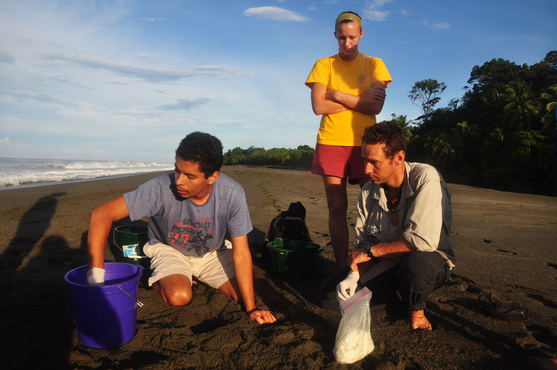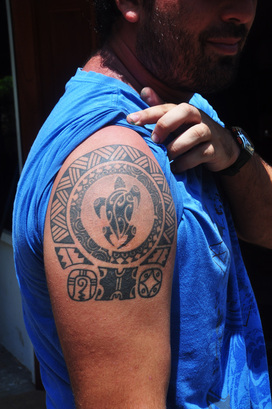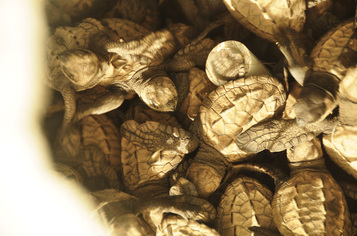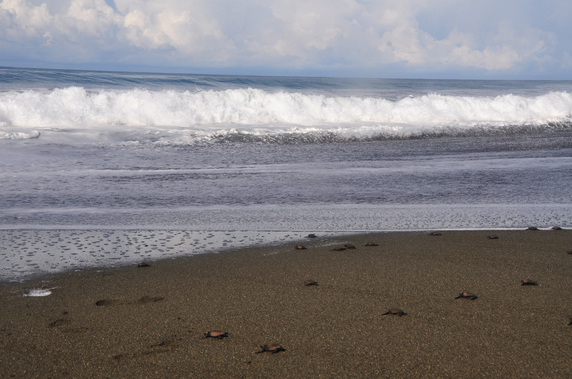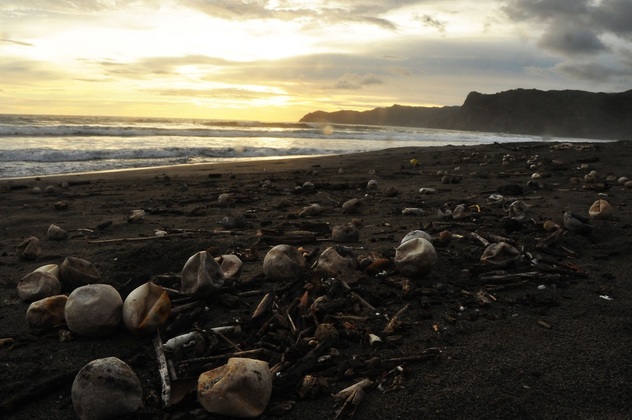These are not sword-wielding turtles moving through the shadows of society to defend humans.
These are flashlight-wielding humans, moving through the shadows of society to defend turtles. They often work alone, usually at night wearing dark clothing. They work long hours for little or no pay, and even less notoriety.
They do it for the turtles.
Until our recent trip to Costa Rica scouting an ASC Guided Outing, I had no idea this underground army existed.
A reserved Costa Rican native named Oscar Brenes, who seemed as much a general naturalist as highly trained biologist, was the first turtle ninja Jeff and I met.
Oscar led us through enormous palm fronds and waxy green philodendrons to the public beach. We stopped just shy of the ocean, in a spot with enough beach sand to build a raised turtle nursery, but remain out of sight from the poachers.
A Reserva Playa Tortuga staff member is here at all times, either sleeping in bug netting on a raised wooden platform during the day, or walking the beach at night collecting eggs from arriving turtles before the poachers can find them.
That night we walked the beach from 10 p.m. to 1 a.m. with Cami, a Reserva Playa Tortuga staff ninja. Flashes of lightning brightened the otherwise black beach.
“Who are these poachers anyway?” I asked. “Are they dangerous?”
Cami’s long blond hair was the only part of her I could see as she turned to answer. “Not dangerous,” she said, “not really.” Her English was hesitant—but she’s from Switzerland and speaks a fair bit of Spanish in addition to several other languages.
“I was in town the other day… and there was a little girl selling turtle eggs. What could I say to her?”
What indeed. Locals have been eating turtle eggs as a delicacy for generations. Some make an illegal living selling turtle eggs; others don’t realize how collecting a few nests impacts turtle populations.
The best estimates are that one baby turtle in a 1,000 will survive long enough to reproduce. Nest success rates vary widely depending on area, tides, temperature, abundance of predators, and problems from fungus to crabs to vultures, coati and humans.
Manuel Sánchez gently placed the soft, squishy, golfball-shaped eggs into a bucket to be relocated to a safer location down the beach or removed to the hatchery. He explained that nests like this one, laid between the high-tide line and river, were guaranteed a partial or total nest failure when the tide shifted the river’s course and exposed the nests.
“We don’t have poaching problems here,” Manuel said, looking down the long strip of palm-fringed sand. “Although they do over there,” he said, pointing to a hazy beach visible in the distance.
We were fortunate that day, because the high tides had forced us to look for nests in the daytime, rather than the usual nighttime prowl. However, because sea turtles almost always nest at night, we had missed the opportunity to collect the eggs as they were being laid. Instead, hours later in the bright tropical sunshine, we had to follow the wide swath of turtle tracks to each nest, and spend a lot of time carefully excavating the eggs before they were washed away as the river shifted its course during the next high tide.
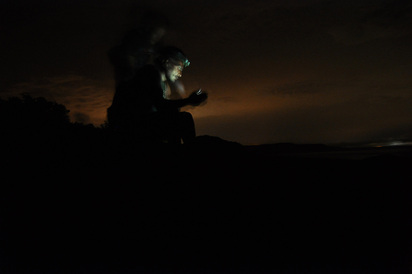 Wilbert, the Nicaraguan turtle ninja master, walks the beach tagging, measuring and collecting data on sea turtles during his eight-hour work night.
Wilbert, the Nicaraguan turtle ninja master, walks the beach tagging, measuring and collecting data on sea turtles during his eight-hour work night.
After a few days on the Osa Peninsula, we traveled up the Pacific Coast to an even more remote beach in Santa Rosa National Park. This was a place we only had access to because we’d come with a biologist from the Osa peninsula, who himself was there by invitation.
In Santa Rosa National Park, we met the ultimate turtle ninja—a turtle master. Wilbert is a short, muscled, Nicaraguan field biologist, who has worked with turtles for 16 years. He has been based at this remote field station for four years.
His workday starts at 8 p.m., when he follows a path through the mangrove forest, bright orange and purple crabs darting out from under his feet. Once on the beach, he spends the next eight hours walking back and forth across one kilometer of sand, tagging, measuring and sometimes taking tissue samples from sea turtles, as well as marking nests for data on success and failure rates. He doesn’t move any nests to keep poachers out, because there are none here. He is the only person, other than the occasional invited visitor or some of Santa Rosa’s park rangers, who will ever walk here.
This is a sacred beach: an arribada beach.
A Spanish word meaning “arrival into port or harbor,” an arribada is an event where tens of thousands of turtles arrive on a particular beach to nest on a single day. There are only two such beaches in Costa Rica where this occurs.
This beach is not only vitally important for conservation and protection, but also for science. The data collected here will help track population numbers, and, via the tissue samples Wilbert collects, help scientists discover where these animals spend their time in the ocean.
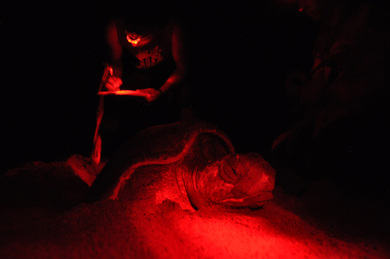 Turtles are disturbed by white headlamps, but not by red light, so it is in this otherworldly red glow that Nikki and Jeff watch a sea turtle lay between 90-120 eggs.
Turtles are disturbed by white headlamps, but not by red light, so it is in this otherworldly red glow that Nikki and Jeff watch a sea turtle lay between 90-120 eggs.
She grunted as she laid around a hundred eggs. Her eyes looked sad and tired in the red light of our headlamps.
As we sat around the picnic table later that next morning, the humidity and heat too sweltering to stay in bed any longer, Wilbert wrote out numbers on a piece of scratch paper. With a little translation help, he explained that the estimated number of turtles that came for arribada, when the beach was discovered in the 1980s, was around 150,000.
The Wednesday before we arrived, 28,000 turtles came to nest.
The reasons for such drastic declines in turtle populations are not well defined or understood, but turtle ninjas, like those we met, are working to learn more.
Every day during the nesting season—and in some places like the Osa, every day of the year—they will be out in the dark, often on their own, working for very little pay or volunteering. They will get exhausted, bitten by no-see-ums and watched by jaguars hunting the turtles. The beaches will be beautiful, haunting and lonely.
And still they will be out there, night after night, for the turtles.

